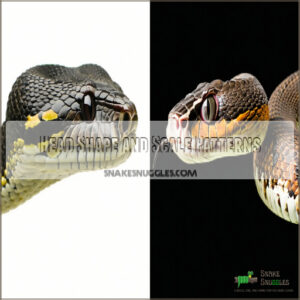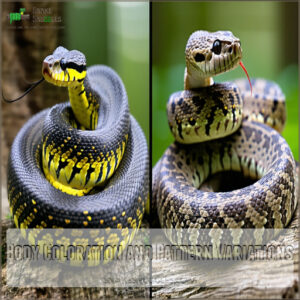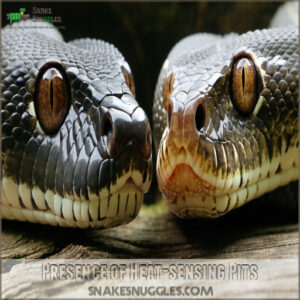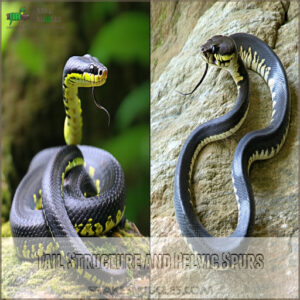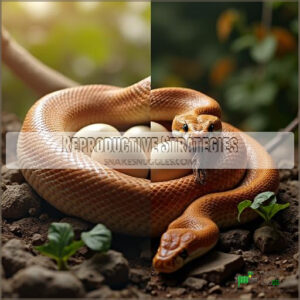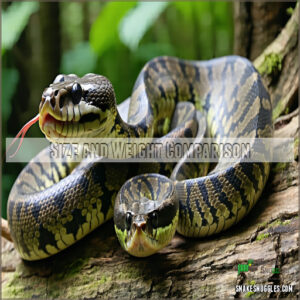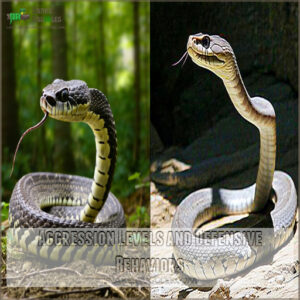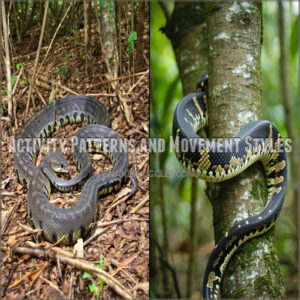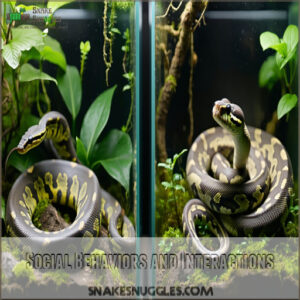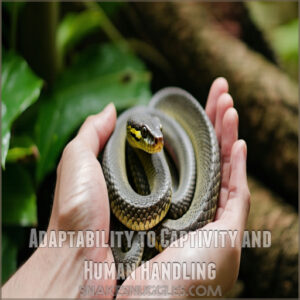This site is supported by our readers. We may earn a commission, at no cost to you, if you purchase through links.
 You’ll find fascinating differences between python vs boa constrictor species, starting with their family trees.
You’ll find fascinating differences between python vs boa constrictor species, starting with their family trees.
Pythons belong to Pythonidae, while boas are part of Boidae. Here’s a cool fact: pythons lay eggs, but boas give live birth!
You’ll spot pythons in Africa, Asia, and Australia, while boas rule the Americas.
Pythons tend to grow larger and have heat-sensing pits that boas lack. They’ve even got extra bones in their skulls and additional teeth.
While both are expert constrictors, boas show more curiosity during handling. Their unique hunting strategies and preferred habitats reveal nature’s incredible adaptability.
Table Of Contents
- Key Takeaways
- Python Vs Boa Constrictor
- Geographic Distribution
- Physical Characteristics
- Reproductive Strategies
- Size and Behavior
- Frequently Asked Questions (FAQs)
- What’s the difference between a python and a boa constrictor?
- Are boas or pythons more aggressive?
- What snake is stronger than a python?
- What is the difference between a python and a snake?
- What is the difference between a python and a boa constrictor?
- Are boas more aggressive than pythons?
- Why is a python called a constrictor?
- Are pythons or boas more aggressive?
- Are boas or pythons better pets?
- What are their respective lifespans in captivity?
- Conclusion
Key Takeaways
- You’ll find pythons and boas in different parts of the world – pythons dominate Africa, Asia, and Australia, while boas rule the Americas, showing how they’ve evolved separately over millions of years.
- You’ll notice major reproductive differences – pythons lay eggs and stay with them during incubation, while boas give live birth and leave their young to fend for themselves immediately.
- You can spot pythons by their heat-sensing pits along their lips and larger size (up to 30 feet), while boas lack these pits and typically max out around 13 feet long.
- You’ll see distinct behaviors in captivity – boas tend to show more curiosity and active exploration, while pythons display shyer temperaments and prefer quieter spaces.
Python Vs Boa Constrictor
You’ll be amazed to learn that pythons and boas, while both impressive constrictors, belong to entirely different snake families with distinct evolutionary histories.
While pythons are members of the Pythonidae family found in Africa, Asia, and Australia, you’ll find boas primarily in the Americas as part of the Boidae family, each with their own unique anatomical features and behaviors.
Family Differences Between Pythons and Boas
Pythons and boas diverged millions of years ago, forming separate family trees.
Boas belong to the Boidae family, while pythons are in Pythonidae.
These snakes differ in reproduction—boas give live birth, but pythons lay eggs.
Boas and pythons exhibit key geographic distinctions.
Skulls also tell the tale: pythons feature extra bones and teeth.
Curious? Let this table clarify these key differences:
| Feature | Boas | Pythons |
|---|---|---|
| Family | Boidae | Pythonidae |
| Reproduction | Live birth | Egg-laying |
| Skull Structure | Fewer bones | Extra premaxilla |
| Taxonomy Variance | Viviparous traits | Oviparous traits |
The table highlights the main distinctions between boas and pythons, including their family and reproduction methods.
These snakes have several unique characteristics that set them apart from one another.
Species Diversity Within Python and Boa Families
Each family boasts impressive genetic variation.
Pythons (Pythonidae) include 31 species, while boas (Boidae) shine with 40. Both showcase stunning biodiversity shaped by evolution.
Here’s a comparison:
| Traits | Boas (Boidae) | Pythons (Pythonidae) |
|---|---|---|
| Species Count | 40 | 31 |
| Major Genera | 15 | 8 |
| Common Habitat Zones | Americas | Asia, Africa, Oceania |
Snake evolution thrives with biodiversity comparison thriving in these families, showcasing their genetic variation.
Evolutionary History and Relationships
Did you know boas and pythons share ancient roots? Their split, seen in fossil records and phylogenetic trees, reveals genetic variation evolving over millions of years.
Think of it as distant cousins branching out.
| Feature | Boidae (Boas) | Pythonidae (Pythons) |
|---|---|---|
| Common Ancestors | Yes | Yes |
| Fossil Records Date | 60 million years | 55 million years |
| Reproduction Type | Live birth | Egg laying |
| Species Divergence | South America | Africa/Asia/Australia |
The table highlights key differences and similarities between the two, showcasing their unique characteristics, such as reproduction type and species divergence.
Geographic Distribution
You’ll find boas mostly in the Americas, while pythons stick to Africa, Asia, and Australia. These distinct ranges highlight their evolutionary paths and adaptations to vastly different environments.
Native Ranges of Pythons and Boas
If you’re wondering about the native ranges of pythons and boas, their geographic distribution truly separates these two snake families.
- Pythons dominate Asia, Africa, and Australia, thriving in lush forests or dry savannas.
- Boas, including the boa constrictor, reign over the Americas, especially South America’s dense rainforests.
- Some pythons, like the Burmese, even expand via species migration into North America.
Understanding python native habitat needs is important for their conservation.
Adaptations to Specific Environments
Boas and pythons handle their environments differently, showcasing unique adaptations to survive.
Boas thrive in diverse climates, from rainforests to arid zones, with astounding habitat flexibility. Pythons, however, excel in tropical regions with sharper environmental pressures.
Check out their distinctions below:
| Trait | Boa Constrictor Habitat | Python Habitat | Fun Fact |
|---|---|---|---|
| Climate Tolerance | Rainforests, savannahs, deserts | Wet tropics, warm grasslands | Pythons love humid areas! |
| Geographic Location | Americas | Africa, Asia, Australia | Strict "old-world" roots. |
| Reptile Adaptation | Arboreal & terrestrial behaviors | Ground-dwelling swimmers | Boas climb; pythons stay low. |
| Ecological Niche | Mixed prey strategies | Precise hunting techniques | Boas are opportunistic feeders. |
The table highlights key differences in climate tolerance, geographic location, reptile adaptation, and ecological niche between boas and pythons, showcasing their unique characteristics and survival strategies in different environments.
Impact of Human Activity on Python and Boa Habitats
Boa and python habitats face growing threats due to habitat loss and human encroachment. Climate change disrupts their ecosystems, while the illegal wildlife trade depletes natural populations.
Conservation efforts aim to counter invasive species and other challenges. Understanding snake size comparisons is paramount for their care.
- Deforestation limits boa constrictor habitat and python ranges.
- Urbanization causes fragmentation and conflict.
- Climate Shifts alter native python vs boa constrictor environments.
Physical Characteristics
When you compare a python to a boa constrictor, you’ll notice differences in their size, bone structure, and coloration.
Pythons can grow substantially longer than boas, and their heat-sensing pits and vibrant patterns set them apart.
Head Shape and Scale Patterns
The boa vs python difference starts with their head morphology.
Pythons have broader heads and complex cranial structures, while boas display narrower shapes.
Scalation types differ too—boas often have smoother scale textures, while some pythons show ridged patterns.
These python vs boa snake appearance traits make identification easier.
Exploring these differences highlights unique adaptations across python and boa families, and showcases the distinct morphology of each species.
Body Coloration and Pattern Variations
When comparing python vs boa snake appearance, their color patterns and marking variations stand out.
Pythons boast vibrant, diverse designs, while boas stick to earthy tones. Both use these traits for camouflage techniques in the wild.
Understanding python boa color differences is essential for identifying species.
- Scale Textures: Pythons have smoother scales, boas appear rougher.
- Skin Shades: Deep gold for pythons, reddish-brown for boas.
- Marking Variations: Stripes in pythons, blotches in boas.
- Camouflage Techniques: Perfect mimicry of environments.
Presence of Heat-sensing Pits
Spotting the prey first is a game changer, and for snakes, infrared detection makes it possible.
Pythons have heat-sensing pits along their lips, acting like thermal vision goggles to catch warm-blooded animals.
These specialized organs contain heat-sensitive TRPA1 proteins.
In the python vs boa battle, boa constrictors don’t use sensory pits—they rely on internal heat sensors instead.
Either way, these constrictors excel at stealth hunting with the help of infrared detection!
Tail Structure and Pelvic Spurs
Feel the difference in their tails—literally.
Pythons have tiny pelvic spurs, leftover “vestigial legs” hinting at their evolutionary past.
These spiky structures may help with mating.
Boa constrictors display slightly smoother tail musculature and lack prominent spurs.
Their tail shape supports tree-gripping strength, unlike ground-dwelling pythons.
Evolution crafted each feature with unique survival strategies, highlighting the importance of evolutionary past and how it influences vestigial legs.
Reproductive Strategies
Regarding reproduction, pythons and boas couldn’t be more different. Pythons lay eggs and carefully incubate them, while boas give birth to live young through internal development.
Python Egg-laying Process and Incubation
Pythons are oviparous, laying eggs instead of giving live birth like a boa constrictor.
With an impressive nesting behavior, female python species coil around their eggs, maintaining warmth and deterring predators.
During the incubation period, lasting up to three months, they rarely leave.
This dedication guarantees successful egg hatching, making their hatchling care a clear evidence of their unique maternal instincts.
Boa Live Birth and Embryonic Development
A boa constrictor’s pregnancy is a fascinating process.
Being ovoviviparous, embryos grow inside the mother during a gestation period of 5-8 months.
Fetal development occurs in the uterus, and live birth guarantees newborns are independent from day one.
This unique trait sets boas apart from python species, making their reproductive strategy perfectly suited to their diverse boa habitat.
The boa constrictor’s reproductive method involves ovoviviparous development that provides protection to the young.
Parental Care Differences Between Pythons and Boas
Regarding maternal care, pythons are doting, while boa constrictors skip babysitting duty.
Python mothers wrap around their eggs, providing warmth and protection through egg incubation. In contrast, boas display no nesting behavior due to live birth instead of eggs.
Their parental investment ends once the babies are born, leaving young boas to fend for themselves immediately.
-
Pythons:
- Maternal care through egg incubation.
- Protective nesting behavior.
-
Boas:
- No maternal care.
- Live birth, no parental involvement.
Reproductive Frequency and Clutch/litter Sizes
Regarding reproductive rates, boa constrictors and pythons operate differently.
Boas give live birth to 10-65 young every two years, while python females lay 15-80 eggs yearly.
Boas pace themselves, but pythons keep their clutch frequency high. Talk about strategy! Their litter size difference reflects how pythonidae size comparison often emphasizes fertility over boa constrictor size efficiency.
| Trait | Boa Constrictor | Python |
|---|---|---|
| Reproductive Cycle | Every 2 Years | Every Year |
| Litter/Clutch Size | 10-65 | 15-80 |
| Egg Production | None (Live Birth) | Eggs Laid (Oviparous) |
| Gestation/Incubation | 100-120 Days (Gestation) | 1-2 Months (Incubation) |
Size and Behavior
Regarding size and behavior, pythons and boas couldn’t be more different.
You’ll notice pythons often grow larger and heavier, while boas are more active and defensive in their interactions.
Size and Weight Comparison
When comparing python vs boa size, pythons take the crown for extremes.
A python’s length can stretch over 30 feet, while boa constrictors max out around 13 feet.
Here’s the breakdown:
- Length differences: Pythons grow larger than boas.
- Weight ranges: Pythons reach 200 pounds; boas average 60.
- Species variations: Different subspecies influence size drastically.
Aggression Levels and Defensive Behaviors
Regarding aggression, boa constrictor vs python behavior shows surprising differences.
Boas, often more defensive, rely on striking behavior when provoked. Pythons, usually shy, avoid confrontation but may strike if cornered.
Snake defense for both depends on aggression triggers like feeling threatened.
Handling temperament varies—boas are curious yet defensive, while pythons remain calm but cautious, exhibiting unique characteristics based on their natural behavior.
Activity Patterns and Movement Styles
Taking a close look at snake movement reveals fascinating distinctions.
Boas are agile climbers, often lingering in trees, while pythons excel at swift ground navigation. Movement speed varies—pythons are quicker, boas deliberate.
Resting patterns differ too; pythons prefer tight spaces. Observing their hunting styles highlights boa versatility and python precision, showcasing their unique approach to survival in diverse habitats.
- Hunting Styles: Boas adapt; pythons strategize.
- Movement Speed: Pythons often outpace boas.
- Climbing Ability: Boas dominate treetops.
- Ground Navigation: Pythons excel on land.
- Resting Patterns: Pythons pick tighter spots, boas rest above ground.
Social Behaviors and Interactions
Social interactions in snakes are fascinatingly minimal. Boa constrictors and pythons prefer solitude, meeting only for mating rituals.
Boas are reactive and defensive, while pythons tend to shy away, prioritizing predator avoidance. Unlike mammals, there’s no social hierarchy or group dynamics to observe. Their reptile interactions? Pure instinct, not friendship!
Understanding ball python behavior is significant for recognizing their unique characteristics and needs.
| Behavior | Boa Constrictor | Python |
|---|---|---|
| Social Hierarchy | None | None |
| Mating Rituals | Indirect Contact | Incubating Role |
| Territorial Marking | Limited | Limited |
| Predator Avoidance | Defensive Strikes | Fleeing |
| Group Dynamics | Solitary Species | Solitary Species |
Adaptability to Captivity and Human Handling
While both species adapt well to captivity, you’ll find boas typically show more curiosity during handling sessions.
These snakes need different enclosure sizes – your boa constrictor thrives in slightly smaller spaces than a python of comparable size.
Enrichment needs vary too; pythons often display shyer temperaments, preferring quiet spaces, while boas actively explore their environment.
Both species can reach impressive captivity lifespans with proper snake handling and care. Proper Boa Constrictor Care is essential for their well-being and longevity.
Frequently Asked Questions (FAQs)
What’s the difference between a python and a boa constrictor?
You’ll find key differences in where they live and how they reproduce.
Pythons lay eggs in Asia and Africa, while boas give live birth in the Americas.
They’ve got different heat-sensing methods too.
Are boas or pythons more aggressive?
You’ll be relieved to know that neither snake is naturally aggressive.
While boas might act more defensive if they’re not used to humans, both species typically prefer to flee rather than fight when confronted.
What snake is stronger than a python?
The green anaconda surpasses the python in strength. You’ll find this massive boa can exert twice the constricting force, crushing with up to 90 PSI compared to a python’s 40 PSI.
What is the difference between a python and a snake?
A python is actually a type of snake – it’s like saying the difference between a car and a Toyota.
All pythons are snakes, but they’re just one special family among many snake species, and this distinction is key to understanding the difference between them.
What is the difference between a python and a boa constrictor?
Despite both being constrictors, you’ll find boas give birth to live young while pythons lay eggs. You’ll notice boas typically reach 13 feet, while pythons can grow beyond 20 feet in length.
Are boas more aggressive than pythons?
You’ll find both snakes prefer flight over fight.
While they’re generally docile, boas can be more defensive if they’re not used to human contact.
Pythons tend to be shyer and more reserved.
Why is a python called a constrictor?
You’ll notice they’re called constrictors because they kill prey by coiling tightly around it and squeezing. This hunting method prevents the prey’s blood flow and breathing, leading to quick unconsciousness.
Are pythons or boas more aggressive?
You’ll find that neither snake tends to be aggressive by nature. Both prefer to flee from confrontation, though boas might act more defensive if they’re not used to human interaction.
Are boas or pythons better pets?
You’ll find both make wonderful pets, but your lifestyle matters most.
Boas tend to be more active and curious when handled, while pythons are typically shyer and calmer, making them perfect for beginners.
What are their respective lifespans in captivity?
With excellent care, you’ll enjoy your boa’s company for 20-40 years , while your python can stay by your side for 15-30 years. These remarkable companions are truly lifetime friends.
Conclusion
Powerful predators prowl through different corners of our planet, making the python vs boa constrictor comparison truly fascinating.
You’ve discovered their unique family histories, distinctive hunting methods, and remarkable adaptations.
Whether it’s the python’s heat-sensing abilities or the boa’s live birth strategy, these magnificent serpents showcase nature’s diverse solutions to survival.
Next time you encounter either species, you’ll appreciate the incredible evolutionary paths that shaped these masterful constrictors into the remarkable creatures they’re today.
- https://www.softschools.com/difference/python_vs_boa_constrictor/331/
- https://www.worldatlas.com/articles/what-are-the-differences-between-a-boa-and-a-python.html
- https://a-z-animals.com/animals/comparison/boa-vs-python-how-to-tell-them-apart/
- https://snake-facts.weebly.com/boa-vs-python-difference.html
- https://www.reddit.com/r/snakes/comments/6yrrdf/boas_vs_pythons/


